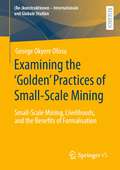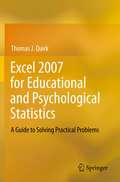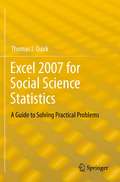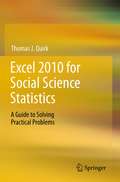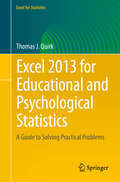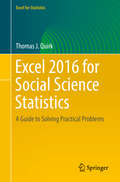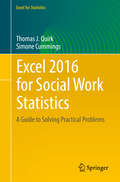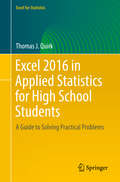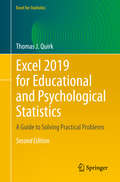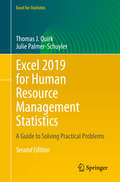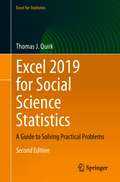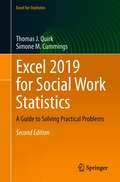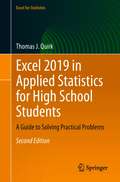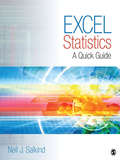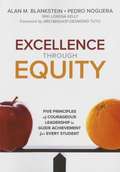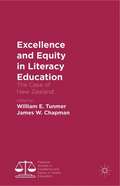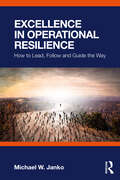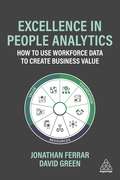- Table View
- List View
Examining Lorraine Hansberry’s A Raisin in the Sun as Counternarrative: Understanding the Black Family and Black Students
by Carl A. GrantExamining Lorraine Hansberry’s A Raisin in the Sun as Counternarrative: Understanding the Black Family and Black Students shows how and why Lorraine Hansberry’s play, A Raisin in the Sun, should be used as a teaching tool to help educators develop a more accurate and authentic understanding of the Black Family. The purpose of this book is to help educators develop a greater awareness of Black children and youth’s, humanity, academic potential and learning capacity, and for teachers to develop the consciousness to disavow white supremacy, American exceptionalism, myths, racial innocence, and personal absolution within the education system. This counternarrative responds to the flawed and racist perceptions, stereotypes, and tropes that are perpetuated in schools and society about the African American family and Black students in US schools. It is deliberative and reverberating in addressing anti-Black racism. It argues that, if Education is to be reimagined through a social justice structure, teachers must be educated with works that include Black artists and educators, and teachers must be committed to decolonizing their own minds. Examining Lorraine Hansberry’s A Raisin in the Sun as Counternarrative: Understanding the Black Family and Black Students is important reading for undergraduate and postgraduate courses in Educational Foundations, Curriculum and Instruction, Education Policy, Multicultural Education, Social Justice Education, and Black Studies. It will also be beneficial reading for in-service educators.
Examining the ‘Golden’ Practices of Small-Scale Mining: Small-Scale Mining, Livelihoods, and the Benefits of Formalisation ((Re-)konstruktionen - Internationale und Globale Studien)
by George Okyere OfosuScholarship on artisanal and small-scale mining (ASM) has often portrayed mining regions as ‘informal’ zones that suffer from environmental degradation problems. Water pollution and degraded landscapes, for example, have long been noted as the inevitable consequence of the operations of ASM. Such insistence on the institutional absences of ASM zones has dovetailed with a lack of academic attention to some of the ‘golden’ mining practices taking place there. Thus, this work seeks to (re)examine the topic of ‘development’ in ASM. The findings suggest that small-scale miners, contrary to popular perception, could be caretakers of the environment. In addition, emphasizing how the dynamic interplay between resources and environmental demands may come to support public policy, the findings illustrate, contrary to the dominant narrative, how the activities of small-scale mining operators can engender a win-win situation for both mining companies and local mining communities.
Excel 2007 for Educational and Psychological Statistics
by Thomas J QuirkThis is the first book to show the capabilities of Microsoft Excel to teach educational and psychological statistics effectively. It is a step-by-step exercise-driven guide for students and practitioners who need to master Excel to solve practical problems using statistics. If understanding statistics isn't your strongest suit, you are not especially mathematically-inclined, or if you are wary of computers, this is the right book for you. Excel, a widely available computer program for students and practitioners, is also an effective teaching and learning tool for quantitative analyses in courses in education and psychology. Its powerful computational ability and graphical functions make learning statistics much easier than in years past. However, Excel 2007 for Educational and Psychological Statistics: A Guide to Solving Practical Problems is the first book to capitalize on these improvements by teaching students and managers how to apply Excel to statistical techniques necessary in their courses and work. Each chapter explains statistical formulas and directs the reader to use Excel commands to solve specific, easy-to-understand statistics problems. Practice problems are provided at the end of each chapter with their solutions in an appendix. Separately, there is a full Practice Test (with answers in an Appendix) that allows readers to test what they have learned.
Excel 2007 for Social Science Statistics
by Thomas J QuirkThis is the first book to show the capabilities of Microsoft Excel to teach social science statistics effectively. It is a step-by-step exercise-driven guide for students and practitioners who need to master Excel to solve practical problems. If understanding statistics isn’t your strongest suit, you are not especially mathematically-inclined, or if you are wary of computers, this is the right book for you. <P> Excel, a widely available computer program for students and managers, is also an effective teaching and learning tool for quantitative analyses in social science courses. Its powerful computational ability and graphical functions make learning statistics much easier than in years past. However, Excel 2007 for Social Science Statistics: A Guide to Solving Practical Problems is the first book to capitalize on these improvements by teaching students and managers how to apply Excel to statistical techniques necessary in their courses and work.<P><P> Each chapter explains statistical formulas and directs the reader to use Excel commands to solve specific, easy-to-understand problems. Practice problems are provided at the end of each chapter with their solutions in an appendix. Separately, there is a full Practice Test (with answers in an Appendix) that allows readers to test what they have learned.
Excel 2010 for Educational and Psychological Statistics
by Thomas J QuirkExcel has become an important and nearly ubiquitous classroom and office resource for students and practitioners who are faced with solving statistical problems on an everyday basis. Despite this, there has yet to emerge a truly practical, "how-do-I-do-it" manual that teaches the various applications and processes/formulas for Excel in educational and psychological Statistics. Quirk's Excel 2010 for Educational and Psychological Statistics will fill this void, as it is designed to be a step-by-step, exercise-driven guide for education and psychology students who need to master Excel to create formulas and solve statistical problems. Each chapter first explains briefly the formulas that are included in the chapter, and then directs the student on how to use Excel commands and formulas to solve a specific business problem. Three practice problems are provided at the end of each chapter, along with their solutions in an Appendix. At the end of the Excel Guide, an additional Practice Exam allows the reader to test his or her understanding of each chapter by attempting to solve a specific educational or psychometrical issue or problem using Excel (the solution to this problem is also given in an Appendix). From the beginning of the book, readers/students are taught how to write their own formulas and then how to utilize Excel drop-down formula menus as well for such exercises involving one-way ANOVA, simple linear regression, and multiple correlation.
Excel 2010 for Social Science Statistics
by Thomas J QuirkThis is the first book to show the capabilities of Microsoft Excel to teach social science statistics effectively. It is a step-by-step exercise-driven guide for students and practitioners who need to master Excel to solve practical social science problems. If understanding statistics isn't your strongest suit, you are not especially mathematically-inclined, or if you are wary of computers, this is the right book for you. Excel, a widely available computer program for students and managers, is also an effective teaching and learning tool for quantitative analyses in social science courses. Its powerful computational ability and graphical functions make learning statistics much easier than in years past. However, Excel 2010 for Social Science Statistics: A Guide to Solving Practical Statistics Problems is the first book to capitalize on these improvements by teaching students and managers how to apply Excel to statistical techniques necessary in their courses and work. Each chapter explains statistical formulas and directs the reader to use Excel commands to solve specific, easy-to-understand social science problems. Practice problems are provided at the end of each chapter with their solutions in an Appendix. Separately, there is a full Practice Test (with answers in an Appendix) that allows readers to test what they have learned. Each chapter explains statistical formulas and directs the reader to use Excel commands to solve specific, easy-to-understand social science problems. Practice problems are provided at the end of each chapter with their solutions in an Appendix. Separately, there is a full Practice Test (with answers in an Appendix) that allows readers to test what they have learned. Includes 164 Illustrations in color.
Excel 2013 for Educational and Psychological Statistics
by Thomas J QuirkThis is the first book to show the capabilities of Microsoft Excel to teach educational and psychological statistics effectively. It is a step-by-step exercise-driven guide for students and practitioners who need to master Excel to solve practical problems in education and psychology. If understanding statistics isn’t your strongest suit, you are not especially mathematically-inclined, or if you are wary of computers, this is the right book for you. <P><P> Excel, a widely available computer program for students and practitioners, is also an effective teaching and learning tool for quantitative analyses in statistics courses. Its powerful computational ability and graphical functions make learning statistics much easier than in years past. However, Excel 2013 for Educational and Psychological Statistics: A Guide to Solving Practical Problems is the first book to capitalize on these improvements by teaching students and practitioners how to apply Excel to statistical techniques necessary in their courses and work.<P> Each chapter explains statistical formulas and directs the reader to use Excel commands to solve specific, easy-to-understand problems in education and psychology. Practice problems are provided at the end of each chapter with their solutions in an appendix. Separately, there is a full Practice Test (with answers in an Appendix) that allows readers to test what they have learned.
Excel 2013 for Social Science Statistics
by Thomas J QuirkThis is the first book to show the capabilities of Microsoft Excel to teach social science statistics effectively. It is a step-by-step exercise-driven guide for students and practitioners who need to master Excel to solve practical social science problems. If understanding statistics isn’t your strongest suit, you are not especially mathematically-inclined, or if you are wary of computers, this is the right book for you.<P><P> Excel, a widely available computer program for students and managers, is also an effective teaching and learning tool for quantitative analyses in social science courses. Its powerful computational ability and graphical functions make learning statistics much easier than in years past. However, Excel 2013 for Social Science Statistics: A Guide to Solving Practical Problems is the first book to capitalize on these improvements by teaching students and managers how to apply Excel to statistical techniques necessary in their courses and work.<P> Each chapter explains statistical formulas and directs the reader to use Excel commands to solve specific, easy-to-understand social science problems. Practice problems are provided at the end of each chapter with their solutions in an Appendix. Separately, there is a full Practice Test (with answers in an Appendix) that allows readers to test what they have learned.
Excel 2016 for Educational and Psychological Statistics: A Guide to Solving Practical Problems (Excel for Statistics)
by Thomas J QuirkThis book shows the capabilities of Microsoft Excel in teaching educational and psychological statistics effectively. Similar to the previously published Excel 2013 for Educational and Psychological Statistics, this book is a step-by-step exercise-driven guide for students and practitioners who need to master Excel to solve practical education and psychology problems. If understanding statistics isn’t your strongest suit, you are not especially mathematically-inclined, or if you are wary of computers, this is the right book for you.<P><P> Excel, a widely available computer program for students and managers, is also an effective teaching and learning tool for quantitative analyses in education and psychology courses. Its powerful computational ability and graphical functions make learning statistics much easier than in years past. However, Excel 2016 for Educational and Psychological Statistics: A Guide to Solving Practical Problems is the first book to capitalize on these improvements by teaching students and managers how to apply Excel to statistical techniques necessary in their courses and work.<P> Each chapter explains statistical formulas and directs the reader to use Excel commands to solve specific, easy-to-understand educational and psychological problems. Practice problems are provided at the end of each chapter with their solutions in an appendix. Separately, there is a full Practice Test (with answers in an Appendix) that allows readers to test what they have learned.
Excel 2016 for Social Science Statistics
by Thomas J QuirkThis book shows the capabilities of Microsoft Excel in teaching social science statistics effectively. Similar to the previously published Excel 2013 for Social Sciences Statistics, this book is a step-by-step exercise-driven guide for students and practitioners who need to master Excel to solve practical social science problems. If understanding statistics isn’t your strongest suit, you are not especially mathematically-inclined, or if you are wary of computers, this is the right book for you.<P><P> Excel, a widely available computer program for students and managers, is also an effective teaching and learning tool for quantitative analyses in social science courses. Its powerful computational ability and graphical functions make learning statistics much easier than in years past. However, Excel 2016 for Social Science Statistics: A Guide to Solving Practical Problems is the first book to capitalize on these improvements by teaching students and managers how to apply Excel to statistical techniques necessary in their courses and work.<P> Each chapter explains statistical formulas and directs the reader to use Excel commands to solve specific, easy-to-understand social science problems. Practice problems are provided at the end of each chapter with their solutions in an appendix. Separately, there is a full Practice Test (with answers in an Appendix) that allows readers to test what they have learned.
Excel 2016 for Social Work Statistics
by Thomas J. Quirk Simone CummingsThis text is a step-by-step guide for students taking a first course in statistics for social work and for social work managers and practitioners who want to learn how to use Excel to solve practical statistics problems in in the workplace, whether or not they have taken a course in statistics. There is no other text for a first course in social work statistics that teaches students, step-by-step, how to use Excel to solve interesting social work statistics problems. Excel 2016 for Social Work Statistics explains statistical formulas and offers practical examples for how students can solve real-world social work statistics problems. This book leaves detailed explanations of statistical theory to other statistics textbooks and focuses entirely on practical, real-world problem solving. Each chapter briefly explains a topic and then demonstrates how to use Excel commands and formulas to solve specific social work statistics problems. This book gives practice in using Excel in two different ways: (1) writing formulas (e. g. , confidence interval about the mean, one-group t-test, two-group t-test, correlation) and (2) using Excel's drop-down formula menus so as not to have to write formulas (e. g. , simple linear regression, multiple correlation and multiple regression, and one-way ANOVA). Three practice problems are provided at the end of each chapter, along with their solutions in an Appendix. An additional Practice Test allows readers to test their understanding of each chapter by attempting to solve a specific practical social work statistics problem using Excel; the solution to each of these problems is also given in an Appendix.
Excel 2016 in Applied Statistics for High School Students: A Guide To Solving Practical Problems (Excel For Statistics Ser.)
by Thomas J. QuirkThis textbook is a step-by-step guide for high school, community college, or undergraduate students who are taking a course in applied statistics and wish to learn how to use Excel to solve statistical problems. All of the statistics problems in this book will come from the following fields of study: business, education, psychology, marketing, engineering and advertising. Students will learn how to perform key statistical tests in Excel without being overwhelmed by statistical theory. Each chapter briefly explains a topic and then demonstrates how to use Excel commands and formulas to solve specific statistics problems. This book gives practice in using Excel in two different ways: (1) writing formulas (e.g., confidence interval about the mean, one-group t-test, two-group t-test, correlation) and (2) using Excel’s drop-down formula menus (e.g., simple linear regression, multiple correlations and multiple regression, and one-way ANOVA). Three practice problems are provided at the end of each chapter, along with their solutions in an Appendix. An additional Practice Test allows readers to test their understanding of each chapter by attempting to solve a specific statistics problem using Excel; the solution to each of these problems is also given in an Appendix. This book is a tool that can be used either by itself or along with any good statistics book. Includes 166 illustrations in color Suitable for high school and community college students.
Excel 2019 for Advertising Statistics: A Guide to Solving Practical Problems (Excel for Statistics)
by Thomas J. Quirk Eric RhineyNewly revised for Excel 2019, this text is a step-by-step guide for students taking a first course in statistics for advertising and for advertising managers and practitioners who want to learn how to use Excel to solve practical statistics problems in the workplace, whether or not they have taken a course in statistics.Excel 2019 for Advertising Statistics explains statistical formulas and offers practical examples for how students can solve real-world advertising statistics problems. Each chapter offers a concise overview of a topic, and then demonstrates how to use Excel commands and formulas to solve specific advertising statistics problems. This book demonstrates how to use Excel 2019 in two different ways: (1) writing formulas (e.g., confidence interval about the mean, one-group t-test, two-group t-test, correlation) and (2) using Excel’s drop-down formula menus (e.g., simple linear regression, multiple correlation and multiple regression, and one-way ANOVA). Three practice problems are provided at the end of each chapter, along with their solutions in an appendix. An additional practice test allows readers to test their understanding of each chapter by attempting to solve a specific practical advertising statistics problem using Excel; the solution to each of these problems is also given in an appendix. This latest edition features a wealth of new end-of-chapter problems and an update of the chapter content throughout.
Excel 2019 for Educational and Psychological Statistics: A Guide to Solving Practical Problems (Excel for Statistics)
by Thomas J. QuirkNewly revised to specifically address Microsoft Excel 2019, this book shows the capabilities of Excel in teaching educational and psychological statistics effectively. Similar to the previously published Excel 2016 for Educational and Psychological Statistics, it is a step-by-step, exercise-driven guide for students and practitioners who need to master Excel to solve practical education and psychology problems.Excel, a widely available computer program for students and managers, is also an effective teaching and learning tool for quantitative analyses in education and psychology courses. Its powerful computational ability and graphical functions make learning statistics much easier than in years past. Excel 2019 for Educational and Psychological Statistics capitalizes on these improvements by teaching students and managers how to apply Excel to statistical techniques necessary in their courses and work.Each chapter explains statistical formulas and directs the reader to use Excel commands to solve specific, easy-to-understand educational and psychological problems. Practice problems are provided at the end of each chapter with their solutions in an appendix. Separately, there is a full practice test (with answers in an appendix) that allows readers to test what they have learned. This new edition features a wealth of new chapter problems and solutions, as well as updated chapter content throughout.
Excel 2019 for Human Resource Management Statistics: A Guide to Solving Practical Problems (Excel for Statistics)
by Thomas J. Quirk Julie Palmer-SchuylerThis book shows the capabilities of Microsoft Excel in teaching human resource management statistics effectively. Similar to the previously published Excel 2016 for Human Resource Management Statistics, this book is a step-by-step, exercise-driven guide for students and practitioners who need to master Excel to solve practical human resource management problems. If understanding statistics isn’t your strongest suit, you are not especially mathematically inclined, or if you are wary of computers, this is the right book for you. Excel, a widely available computer program for students and managers, is also an effective teaching and learning tool for quantitative analyses in human resource management courses. Its powerful computational ability and graphical functions make learning statistics much easier than in years past. However, Excel 2019 for Human Resource Management Statistics: A Guide to Solving Practical Problems, 2nd Edition, capitalizes on these improvements by teaching students and managers how to apply Excel to statistical techniques necessary in their courses and work. Each chapter explains statistical formulas and directs the reader to use Excel commands to solve specific, easy-to-understand human resource management problems. Practice problems are provided at the end of each chapter with their solutions in an appendix. Separately, there is a full practice test (with answers in an appendix) that allows readers to test what they have learned.
Excel 2019 for Social Science Statistics: A Guide to Solving Practical Problems (Excel for Statistics)
by Thomas J. QuirkThis book shows the capabilities of Microsoft Excel in teaching social science statistics effectively. Similar to the previously published Excel 2016 for Social Sciences Statistics, this book is a step-by-step, exercise-driven guide for students and practitioners who need to master Excel to solve practical social science problems. If understanding statistics isn’t your strongest suit, you are not especially mathematically inclined, or you are wary of computers, this is the right book for you.Excel, a widely available computer program for students and managers, is also an effective teaching and learning tool for quantitative analyses in social science courses. Its powerful computational ability and graphical functions make learning statistics much easier than in years past. Excel 2019 for Social Science Statistics: A Guide to Solving Practical Problems capitalizes on these improvements by teaching students and managers how to apply Excel to statistical techniques necessary in their courses and work.In this new edition, each chapter explains statistical formulas and directs the reader to use Excel commands to solve specific, easy-to-understand social science problems. Practice problems are provided at the end of each chapter with their solutions in an appendix. Separately, there is a full practice test (with answers in an appendix) that allows readers to test what they have learned.
Excel 2019 for Social Work Statistics: A Guide to Solving Practical Problems (Excel for Statistics)
by Thomas J. Quirk Simone M. CummingsThis text is a step-by-step, exercise-driven guide for students and practitioners who need to master Excel to solve practical social work problems. If understanding statistics isn’t your strongest suit, you are not especially mathematically inclined, or if you are wary of computers, this is the right book for you. Excel, a widely available computer program for students and managers, is also an effective teaching and learning tool for quantitative analyses in social work courses. Its powerful computational ability and graphical functions make learning statistics much easier than in years past. Excel 2019 for Social Work Statistics: A Guide to Solving Practical Problems capitalizes on these improvements by teaching students and managers how to apply Excel to statistical techniques necessary in their courses and work. In this new edition, each chapter explains statistical formulas and directs the reader to use Excel commands to solve specific, easy-to-understand social work problems. Practice problems are provided at the end of each chapter with their solutions in an Appendix. Separately, there is a full Practice Test (with answers in an Appendix) that allows readers to test what they have learned.
Excel 2019 in Applied Statistics for High School Students: A Guide to Solving Practical Problems (Excel for Statistics)
by Thomas J. QuirkThis textbook is a step-by-step guide for high school, community college, and undergraduate students who are taking a course in applied statistics and wish to learn how to use Excel to solve statistical problems. All of the statistics problems in this book come from the following fields of study: business, education, psychology, marketing, engineering and advertising. Students will learn how to perform key statistical tests in Excel without being overwhelmed by statistical theory. Each chapter briefly explains a topic and then demonstrates how to use Excel commands and formulas to solve specific statistics problems. The book offers guidance in using Excel in two different ways: (1) writing formulas (e.g., confidence interval about the mean, one-group t-test, two-group t-test, correlation) and (2) using Excel’s drop-down formula menus (e.g., simple linear regression, multiple correlations and multiple regression, and one-way ANOVA). Three practice problems are provided at the end of each chapter, along with their solutions in an appendix. An additional practice test allows readers to test their understanding of each chapter by attempting to solve a specific statistics problem using Excel; the solution to each of these problems is also given in an appendix. This book is a tool that can be used either by itself or along with any good statistics book.
Excel Statistics: A Quick Guide
by Neil J. SalkindBecome a pro at using Excel for statistical analysis! Designed for users already familiar with basic computer operations, Neil J. Salkind's Excel Statistics: A Quick Guide shows readers how to utilize the features of Microsoft Excel to answer both simple and complex questions about data analysis. Excel novices and experts alike will find this text not only practical but easy to use and engaging.
Excel Statistics: A Quick Guide
by Neil J. SalkindIdeal for those already familiar with basic Excel features, this updated Third Edition of Neil J. Salkind’s Excel Statistics: A Quick Guide shows readers how to utilize Microsoft® Excel’s functions and Analysis ToolPak to answer simple and complex questions about data. Part I explores 35 Excel functions, while Part II contains 20 Analysis ToolPak tools. To make it easy to see what each function or tool looks like when applied, at-a-glance two-page spreads describe each function and its use with corresponding screenshots. In addition, actual data files used in the examples are readily available online at an open-access Student Study Site.
Excel Statistics: A Quick Guide
by Neil J. SalkindIdeal for those already familiar with basic Excel features, this updated Third Edition of Neil J. Salkind’s Excel Statistics: A Quick Guide shows readers how to utilize Microsoft® Excel’s functions and Analysis ToolPak to answer simple and complex questions about data. Part I explores 35 Excel functions, while Part II contains 20 Analysis ToolPak tools. To make it easy to see what each function or tool looks like when applied, at-a-glance two-page spreads describe each function and its use with corresponding screenshots. In addition, actual data files used in the examples are readily available online at an open-access Student Study Site.
Excellence Through Equity
by Pedro Noguera Alan M. BlanksteinCourageous, inspiring examples of educational equity in action! This illuminating book builds the case that equity is the most powerful means we have to lift all children to higher achievement and to benefit society at large. Readers will find: Examples of high-leverage practices used by award-winning schools and districts System-level examples of excellence through equity including whole state and district-wide Examples of classroom level practice that lead to success for students from underserved populations as well as for their more privileged peers A powerful concluding chapter that focuses on what we can learn from other nations that have pursued the goals of educational equity
Excellence and Equity in Literacy Education
by William E. Tunmer James W. ChapmanLiteracy is arguably the most important goal of schooling as, to a large extent, it determines young children's educational and life chances and is fundamental in achieving social justice. New Zealand's literacy education programme has long been regarded as one of the world's most successful approaches to teaching literacy skills to young children. Excellence and Equity in Literacy Education questions this widely held assumption. In the late 1990s the New Zealand government developed a national literacy strategy aimed at reducing persistently large inequities in literacy achievement outcomes. The chapters in this edited volume present evidence indicating that the national literacy strategy has failed, examine the major factors responsible for the continuation of New Zealand's comparatively wide spread of scores in literacy achievement, and describe the most effective strategies for reducing the literacy achievement gap and achieving excellence and equity in New Zealand literacy education.
Excellence in Operational Resilience: How to Lead, Follow and Guide the Way
by Michael W. JankoProviding essential guidance to thrive in a complex environment, this book showcases tools to take the leadership role in the process of building resilience in any organization in a timely, effective, and practical way for today’s risks and tomorrow’s challenges.All organizations seek to be resilient, yet most do not have a clear definition of what that means for them, or a plan to manage the journey to attain it. This resilience playbook includes the right combination of technical knowledge, team structure, leadership support, and behavioral competencies, all based on a clear “Lead, Follow, Guide” framework. Based on the author’s three decades of successfully implementing resilience-based strategies at Goodyear and other major firms, this book offers road-tested advice and techniques to bring quick wins and long-term success in organizational resilience.With this book to assist, risk-savvy executive leaders and professionals working in business continuity, risk management, security, IT, supply chain, operations management, and process improvement will maintain a constant pulse on their journey towards resilience, keep the right people engaged, and create a team-based approach to reach their goals.
Excellence in People Analytics: How to Use Workforce Data to Create Business Value
by David Green Jonathan FerrarEffectively and ethically leveraging people data to deliver real business value is what sets the best HR leaders and teams apart. Excellence in People Analytics provides business and human resources leaders with everything they need to know about creating value from people analytics.Written by two leading experts in the field, this practical guide outlines how to create sustainable business value with people analytics and develop a data-driven culture in HR. Most importantly, it allows HR professionals and business executives to translate their data into tangible actions to improve business performance. while navigating the rapidly evolving world of work. Full of practical tools and advice assembled around the Insight222 Nine Dimensions in People Analytics® model, this book demonstrates how to use people data to increase profits, improve staff retention and workplace productivity as well as develop individual employee experience. Featuring case studies from leading companies including Microsoft, HSBC, Syngenta, Capital One, Novartis, Bosch, Uber, Santander Brasil and American Eagle Outfitters®, Excellence in People Analytics is essential reading for all HR professionals needing to unlock the potential in their people data and gain competitive advantage

